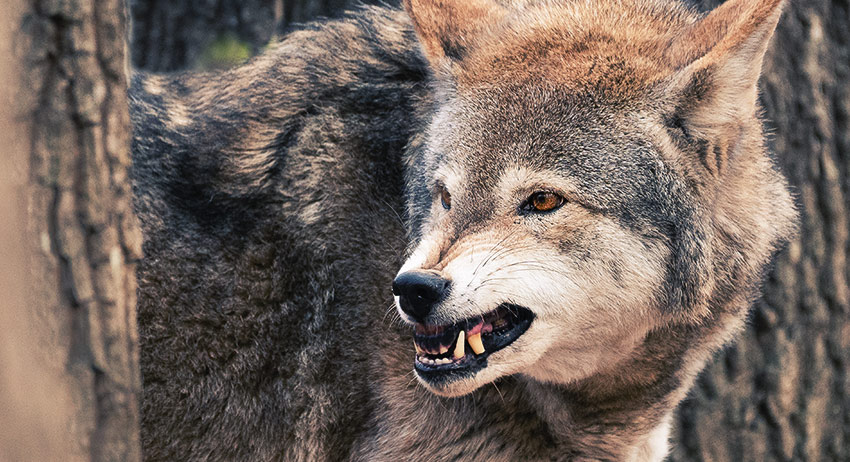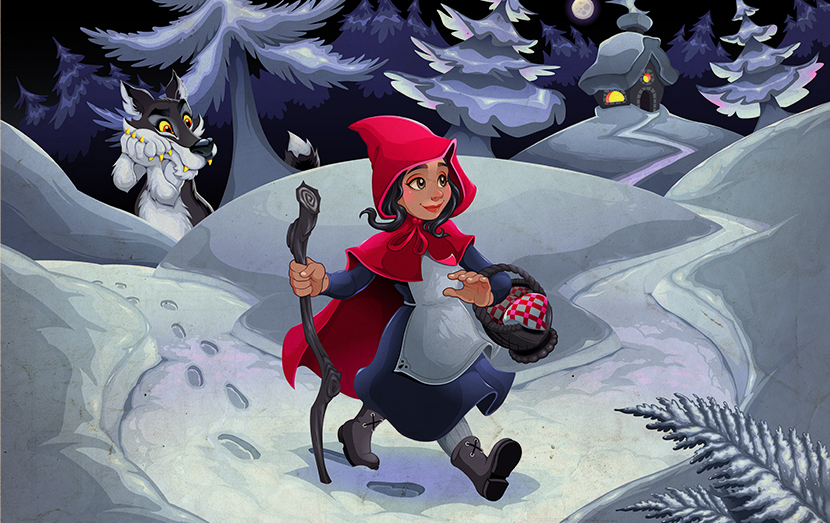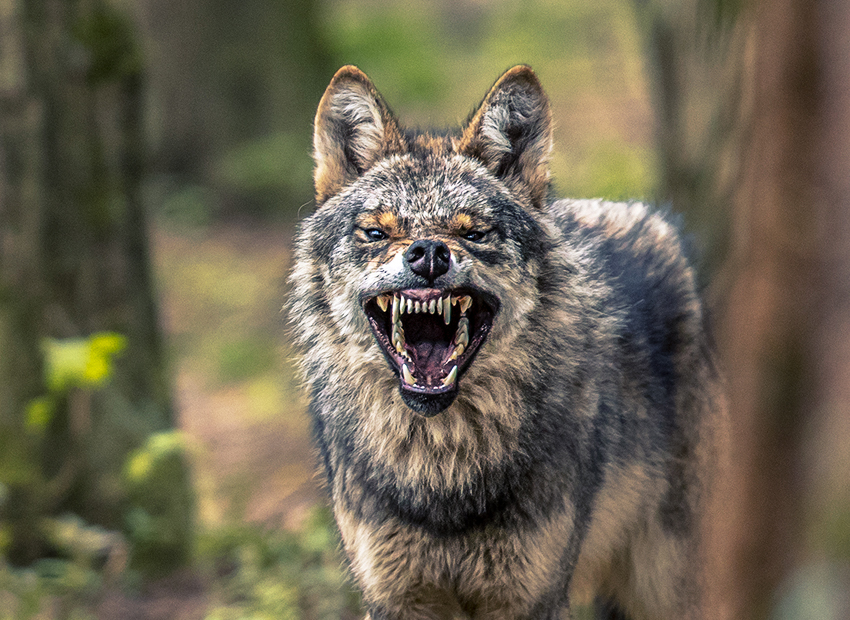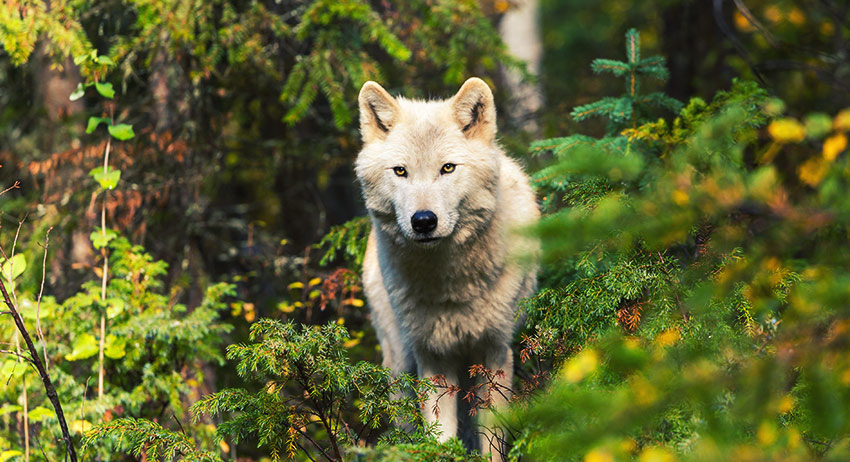How to Survive a Wolf Attack

Today, wolves are returning to our natural landscapes. Wolf attacks are rare but they do happen. Are they to be feared, loved, or both?

In this article I want to break down wolf behavior so that you can avoid negative impacts with wolves. I want to touch on their behavior, and historical accounts of deaths from wolves. I’ll also give you step by step instructions on how to survive a wolf attack, at least as best we can according to science.
Of note: If you prefer to listen to this information about wolves, I have recorded an audible version of it of which you can find at the bottom of this page.
Wolf Basics
If you didn’t already know this, dogs are a recent evolutionary off-shoot of wolves. So when you talk about wolves, you’re talking about the ancestors of modern dogs too. With that said, think about your relationship with dogs? Most people know of a sweet dog and potentially also have had some interaction with a mean dog. There are varying degrees of aggression in dogs (something I’ve written about before). Part of being a human today is learning to read their behavior and avoid getting bitten. That’s exactly what we’re going to do here with their wild cousins, wolves.

Before we start, keep this important framework in mind – dogs are the domesticated versions of wolves. That means, all dogs started a long time ago with wolf genetics. Over time, we selected dogs for different characteristics. Sometimes it was to be good natured and loyal to us and other times for a particular color or for hunting aptitude. We’ve even bred dogs to be more aggressive and better at fighting and attacking. Dogs have significant variation in characteristics. Wolves do as well. Even within gray wolves, which I’ll be concentrating on here, there are differences in behavior depending on where they live.
In their natural habitat, wolves survive as predators that hunt in packs. By hunting in a group, they can take down large prey – like moose, bison and musk-ox. These are formidable animals, and thus, from a capability standpoint, wolves could easily take down a human. A person going for their morning run would be easy pickings for a pack of animals who can take down a moose! The fact that they don’t more often is a testament to how smart they are – and that humans aren’t really on the menu.
Even so, there are countless legends of ferocious wolves – from Little Red Riding hood to the Big Bad Wolf and Werewolves. These European legends almost always portray them as the villain. These stories have ingrained in most European and asian cultures a deep-seated fear of wolves. Yet, it’s worth pointing out that these stories didn’t exist in native American cultures in the new world. While you might interpret this fact in different ways, it could be an indicator that the behavior between European and North American wolves is very different.

The reason for much of these European legends stemmed from a very real danger of Eurasian wolves in the recent past. In France, where the best records of this type were kept, there were 7,600 fatal wolf attacks from 1200 to 1920. Even in the last 50 years, when wolves have been mostly eliminated across the world, there were 8 fatal attacks in Europe and Russia and 200 in south Asia.
But, let’s be clear before we move on, that you have to take all of the historical data on wolf attacks in context. Dogs kill an average of 25,000 people a year from dog bites – mostly from rabies infection. Plus, there are thousands of hikers roaming wolf country in hotspots like Yellowstone and Banff with no attacks to report. States like Minnesota, Wisconsin, Oregon, Washington, Idaho have had almost no problems with people and wolves. This is important to point out because you shouldn’t really be afraid of wolves, at least in the modern world we live in. But should you somehow bump into a wolf pack that’s brazen and aggressive, here are some recommendations of what you might do.
Scenarios to Avoid with Wolves
Be cautious bringing a dog off-leash in wolf country. If this doesn’t make sense right away, think about the conflicts with dogs that often occur at dog parks when a dog gets into a tussle with a bigger dog. It’s the dog-dog interaction that sometimes leads to the conflict.
Avoid hiking and camping alone in areas wolves are known to traverse. Rangers at stations and camp-grounds are good resources to ask if you’re looking for information on wolves in the area before hiking in and setting up camp.
Don’t habituate a wolf to humans, either by feeding them or letting them get too comfortable around you. This is when conflicts occur – if not for you, then possibly others. The reason for this is that wolves are smart and quickly learn from humans if given the chance. They may try to outsmart you or treat you like one of the pack. If that does occur, you better hope they treat you like the alpha.
Stay away from fresh wolf kills, dens, or rendezvous sites if you happen upon them. Again, park rangers are a great asset for local knowledge so you can minimize your risk of ending up in a more risky area.
Don’t let children play away from camp or alone in wolf country. These canines are large, and a child is easy prey.
The Most Dangerous Wolves
More often than not, wolf “attacks” happen either with wolf-dog hybrids or in facilities where wolves have habituated to humans. Habituated wolves tend to have more attacks simply because you’re bringing already aggressive and large animals into close contact with humans. For perspective though, while there are only a few wolf related deaths a decade, about 4.5 million dog bites are reported each year in the US alone and lead to about 30-50 deaths.

The most dangerous wolf, however, is a rabid wolf. If wolves contract rabies, they develop what is known as the “furious” phase of rabies to a much higher degree than other animals. Mix that with their size and power, and you get a formidable rabid animal.
Rabid attacks usually occur in the spring and fall – and for each animal only during the course of one day. From 1950 to 2002, there were 8 fatal rabid wolf attacks in Europe and more than 200 in southern Asia. Of note, that’s also where a lot of the dog-rabies originate.
How to Survive a Wolf Attack?
If you see a wolf, most of the time they will run away. They want nothing to do with you. Wolves are so stealthy that actually encountering one could be seen as a lucky experience – I’ve only seen random wolves in the woods a few times. Of course, if something else is at play and you encounter wolves in the wild that you deem are acting predatory in nature, here are some steps you can take to get out of the situation.
- Stay calm. They’re smart and, because they’re pack animals that test their prey for weakness, they will be testing you.
- Don’t run. For goodness sake, this is the worst thing you can do. Running instantly puts you in a prey category in their minds – and you’re not faster than a wolf! If you’ve ever had a dog bite at your heels, you know this. You can think of it in a similar way for wolves – but with higher stakes.
- Let them know you’re dominant. That means you make yourself big and tall. Wave your arms. You should maintain eye contact. We are not a wolf’s normal prey, but they’re smart. Don’t let them learn you’re weak.
- If you do encounter a wolf when you have a dog, bring your dog to your side and leash it immediately. Stand between the wolf and your dog. That often ends the encounter.
The Take home on Wolves:
If you do get to see a wolf, you really are lucky. They’ve learned how to navigate their environment through trial and error over millennia. In Eurasia they have learned for hundreds of thousands of years living side-by-side with humans that we’re not ones to be messed with. Wolves instinctively keep their distance. While a few rare aggressive encounters pop up in the news, they’re the exception, not the rule.
Now that you know a bit about wolf behavior and have a few key survival strategies up your sleeve, my hope is that you can have a sense of joy in the rare event that you see a wolf from a distance. They are amazing creatures.

Why I wrote this:
Wolves of Chernobyl: An Introduction
In 2014, I hosted a documentary investigating the so-called radioactive wolves within the Chernobyl exclusion zone – the fallout zone of the worst nuclear disaster in history. We were looking for wolves in the legendary forests of what is now northern Ukraine. A big reason we were there was because there were reports of aggressive wolves that were attacking soldiers inside the zone. Thus, we set out to figure out the mystery and get to the bottom of these “radioactive wolves.”
For ten days we set camera traps and worked with a local wolf biologist to understand their behaviors. At one point we called the wolves to within a hundred yards of us. The sound of a wolf howling back at you in the radioactive forest of Chernobyl is both thrilling and chilling. It is so much louder than what you’d expect, and hearing them all around you is a bit unnerving.
It turns out that the radiation wasn’t making the wolves any more aggressive. Instead, rabies was causing the wolves to attack the soldiers. In fact, while the wolves there did have relatively large amounts of radioactive isotopes in their tissues, the damaging effects of that were much less than the usual hunting pressure from humans. Inside the zone they’re actually doing 3 times better than in areas outside the zone!
Oddly I’ve never really feared wolves. Just about every old fairy-tail and legend portrays them as killers. But I also watched Kevin Costner’s Dances with Wolves (a classic movie of a Civil War soldier that befriends a wolf). Plus, there were no wolves in the woods when I was growing up. I never heard local stories about attacks or even sightings. But today, wolves are returning to our natural landscapes. So what is the truth? Are they to be feared, loved, or both?
Prefer to Listen to Wolves?
If you like listening to these stories, I’ve tried to make this as accessible as possible by recording it here:
Wolf Videos You Might Like
Here is a video on the Red Wolf that I made last year as well as a video about the wolves of Chernobyl. Both are a fun watch.

